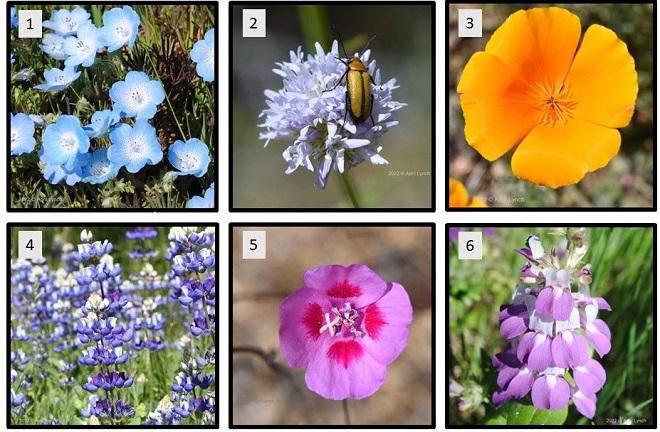
Wildflowers

Spring-blooming California wildflowers blanketing their native habitats create one of the most spectacular floral scenes. In gardens, splashes of dynamic colors mimic their eye-catching native splendor if only for a few weeks each year. But even after blossoms fade, they continue to enhance the garden by attracting seed-eating birds and dropping ample seeds that germinate the following year.
Most California wildflowers are annuals that complete their life cycle from seed to flowering to reseeding in one year. A few favorites, such as California poppies (Eschscholzia californica), are perennials. They may die back to the ground after flowering, but in some microclimates, they often bloom sporadically throughout summer and fall.
Getting Started
Nearly all California native wildflowers need at least 6-8 hours of sun a day. They do well in rock gardens, around mailboxes, in borders, and along fences, driveways, and walkways. Try starting with a small patch or two then, over time, watch as they seed themselves into nearby spaces. Most gardeners opt to sow seeds just before the onset of the fall rainy season. Since they prefer well-drained soil, avoid planting seeds in areas that stay soggy after a heavy rain.
Prepare a site in your garden a week or two before you plan to sow seeds. First, remove any weeds and grass that can compete with new wildflower seedlings. After you have removed the existing vegetation, loosen the soil to a depth of no more than 1-2 in. to keep the dormant weeds covered, and water well. After 2 weeks or so, remove any new weeds that have sprouted.
Sowing Seeds
Moisten the soil thoroughly before you seed the area. Mix the wildflower seeds with horticultural sand or vermiculite to make spreading easier. Don’t bury the seeds or they won’t sprout. Instead, scatter seed by hand or use a seed dispersal tool to insure even distribution. Lightly rake or sprinkle the seeded area but avoid covering seeds completely. You can also press the seed in with a piece of cardboard.
Ongoing Care
Keep the area moist, but not saturated, until seeds germinate. If all goes well, the fall and winter rains will provide enough moisture. During drought years, be prepared to provide supplemental irrigation after seeding and throughout the bloom period.
Your own microclimate and planting location will affect the way your wildflowers grow. Plants in coastal microclimates can withstand more sun and get by with less watering than those in hot, inland areas.
Making Selections
Following is a list of some annual wildflowers that do well in most of Sonoma County and will reseed in successive years.
- Baby blue-eyes, Nemophila menziesii, has light-blue blossoms with white centers that look great in containers. Baby-white eyes, Nemophila menziesii var. atomaria, has white flowers sprinkled with tiny blue dots. Five spot flowers, maculata, are white with five petals. Each petal has a dark purple spot on its tip.
- Blue field gilia, Gilia capitata, has 1-in. dense heads of many powder-blue flowers on long stems that grow up to 24 in. tall. Flowers appear between February and March. Bird’s eyes, Gilia tricolor, is endemic to Sonoma County and does well in dry ground. The fragrant blue, lavender, violet and pink flowers attract hummingbirds and butterflies. They grow to 8 in. tall April through August.
- California poppies, Eschscholzia californica, are yellow-orange flowers that reseed prolifically. They grow from 2–24 in. tall, depending on the environment, from February through September. Ragged plants can be pruned back to near ground level after the seed pods dry. Collect the dry seeds and sow them in other areas of your garden. Tufted poppies, Eschscholziacaespitosa, are often mistaken for California poppies. They grow from 2–12 in. tall and bloom from March through August.
- Sky lupine, Lupinus nanus, is an excellent companion for poppies. Dense whorls of blue flowers with white tips grow on upright spikes about 10–15 in. tall. They bloom from March through May and are an important host plant for a great number of insects. There are over a hundred species of lupine in California that come in a variety of colors, including blue, pink, white and yellow.
- Sonoma Clarkia, Clarkia gracilis ssp. sonomensis, has a brilliant pink flower with a magenta spot on the base of each petal. It grows up to 12 in. tall and is notorious for its drooping buds. Red ribbons, Clarkia concinna, grow well in the shade and up to 18 in. tall. Elegant clarkia, unguiculata, with diamond-shaped petals, grows 2 ft. tall. Since all Clarkias bloom from April to July, their common name is farewell-to-spring.
- Chinese houses, or pagodas, Collinsia heterophylla, tolerate shade. These delightful flowers emerge in colors of white, rose and purple. Blooms are tiered in whorls with a lilac or white upper lip and a rose-purple or violet lower lip. They bloom from February to April and grow up to 10 in. tall. They make a good bulb cover.

For more information visit:
- Recommended Plants for Sonoma County
- Sow wildflower seeds now for a spring display
- Information on California wild plants (Calflora.org)
November 2022







